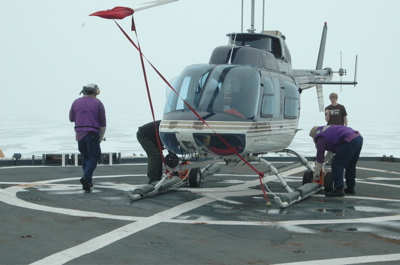( Log In ) Log In is for TREC Teachers & Researchers only
  |
| Steve_Stevenoski |
 Aug 7 2006, 02:04 AM Aug 7 2006, 02:04 AM
Post
#1
|
|
Member   Group: TREC Team Posts: 27 Joined: 19-July 06 Member No.: 39 |
August 4, 2006
Coast Guard Day Barbeque  The 4th of August is Coast Guard Day. The Coast Guard was founded 216(?) years ago. The ship celebrates Coast Guard day with a number of special activities. A lunchtime barbeque was hosted on the flight deck and helicopter hanger. Grilled chicken, hot dogs, and burgers were served with a buffet of salads, corn on the cob, beans and deserts. A pie-eating contest won by DC1 Pentecost was one of the highlights of the day. Many of the Coast Guard spent the afternoon playing board games in the mess. In general, the day was a holiday from the Coast Guard regular schedule. Those who help out with the science stayed with their normal routines, but everyone stopped to partake in the barbeque. Pie Eating Contest  Just after lunch, we started to deploy the piston corer. Depending on the depth of the water it can take two to four hours for the corer to make the trip up and down. The area that was selected today was chosen based on the bathymetry data. The seafloor in this location appeared to be a small seamount. Collecting the sediments in the vicinity of the feature could support this hypothesis. When the core was brought on deck, it was shorter than they had hoped. The corer had not penetrated the basement. The core was predominately gravely material. From the core alone, the scientists could not be sure of the age or the origin of the feature. Most of the day was devoted to collecting the seismic instruments off the ice. Helicopter flights continued throughout the day. The scientists have a general idea of the location of each instrument based upon the movement of the ice due to drift and wind. The ship is not in constant radio contact with the ship. We need to be within about 10 miles of the instrument to communicate. When the helicopters go out, a person operating a handheld GPS unit with the coordinate of the instrument assists the pilot. They then fly to the area and do a visual search until it is found. Depending on the weather and the ice this can take up to an hour. Helicopter Preparation  By dinner, we had recovered nine of the twelve instruments on the ice. As we traveled west the ship path would parallel the instruments. As the ship entered the general location of the instrument, another flight was sent out. Number 10 instrument was actually sited by a crew person in the aloft con about two miles from the ship just before midnight. That made recovery very easy. Repair work continued on the cage. The order of the day was to cut, weld, and drill and fabricate the aft part of the cage to secure three Bolt guns instead of four. Josh our Coast Guard welder worked until 9:30 to finish the work. At 7:00 there was a science presentation open to everyone aboard. Steffen had participated in a seismic cruise in the spring of 2005 to determine what had occurred on the seafloor during the 9.2 earthquake that had produce the December Tsunami that had killed a quarter of million people in Indonesia. Steffen was part of a group of international scientists that spent almost three weeks doing a seismic survey of the seafloor to find the region of the fault that had fractured to produce the Tsunami. The entire cruise was recorded to produce a documentary shown on the Discovery Channel. Steffen presented the video and discussed the science of Tsunamis and the science that was conducted during the cruise. Not only is Steffen a really cool and knowledgeable scientist, now he is also a TV celebrity. |
  |
2 User(s) are reading this topic (2 Guests and 0 Anonymous Users)
0 Members:

|
NSF Acknowledgment & Disclaimer | Time is now: 1st November 2024 - 06:36 AM |
Invision Power Board
v2.1.7 © 2024 IPS, Inc.








